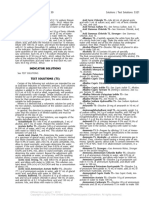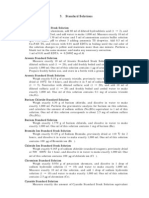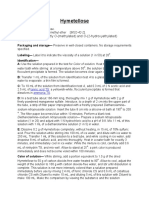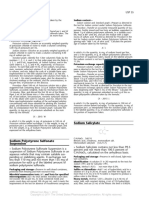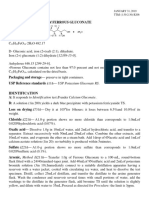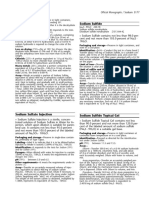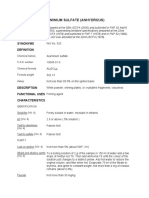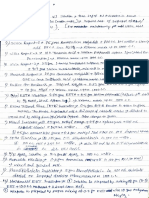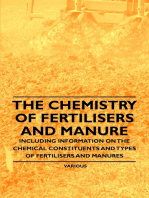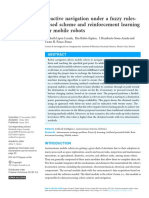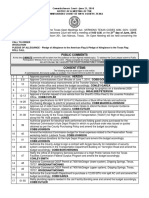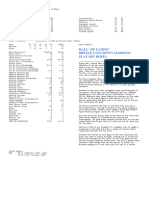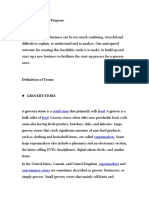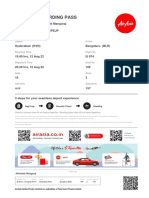5328-5337 Volumetric Solutions
5328-5337 Volumetric Solutions
Uploaded by
ismail khurshidCopyright:
Available Formats
5328-5337 Volumetric Solutions
5328-5337 Volumetric Solutions
Uploaded by
ismail khurshidOriginal Description:
Copyright
Available Formats
Share this document
Did you find this document useful?
Is this content inappropriate?
Copyright:
Available Formats
5328-5337 Volumetric Solutions
5328-5337 Volumetric Solutions
Uploaded by
ismail khurshidCopyright:
Available Formats
Accessed from 128.83.63.
20 by nEwp0rt1 on Tue Jun 12 01:43:01 EDT 2012
5328 Test Solutions / Solutions First Supplement to USP 35–NF 30
for 5 minutes with 1 g of aluminum oxide, and filter to concentration to between 94.5% and 95.5% (w/w) of
clarify. H2SO4.
Sodium Thioglycolate TS—Dissolve 1.5 g of sodium thi- [NOTE—Since the acid concentration may change upon
oglycolate in 450 mL of water, and add 50 mL of alcohol. standing or upon intermittent use, the concentration should
Use within 3 days. be checked frequently and solutions assaying more than
Sodium Thiosulfate TS—Use 0.1 N Sodium Thiosulfate 95.5% or less than 94.5% discarded.]
(see in the section Volumetric Solutions). Sulfuric Acid–Formaldehyde TS—Add 1 drop of formal-
Standard Lead Solution—See under Heavy Metals 〈231〉. dehyde TS to each mL of sulfuric acid, and mix. Prepare this
Stannous Chloride, Acid, TS—Dissolve 8 g of stannous solution fresh.
chloride in 500 mL of hydrochloric acid. Store in glass con- Tannic Acid TS—Dissolve 1 g of tannic acid in 1 mL of
tainers, and use within 3 months. alcohol, and dilute with water to 10 mL. Prepare this solu-
Stannous Chloride, Acid, Stronger, TS—Dissolve 40 g tion fresh.
of stannous chloride in 100 mL of hydrochloric acid. Store Tartaric Acid TS—Dissolve 3 g of tartaric acid in water to
in glass containers, and use within 3 months. make 10 mL. Prepare this solution fresh.
Starch TS—Mix 1 g of soluble starch with 10 mg of red Tetrabromophenolphthalein Ethyl Ester TS—Dissolve
mercuric iodide and sufficient cold water to make a thin 100 mg of tetrabromophenolphthalein ethyl ester in 90 mL
paste. Add 200 mL of boiling water, and boil for 1 minute of glacial acetic acid, and dilute with glacial acetic acid to
with continuous stirring. Cool, and use only the clear solu- 100 mL. Prepare this solution fresh.
tion. [NOTE—Commercially available, stabilized starch indica- Tetramethylammonium Hydroxide TS—Use an aqueous
tor solutions may be used, including mercury-free solutions solution containing, in each 100 mL, the equivalent of 10 g
preserved with other compounds such as salicylic acid.] of anhydrous tetramethylammonium hydroxide.
Starch, Iodide-Free, TS—Mix 1 g of soluble starch with Thioacetamide TS—Dissolve 4 g of thioacetamide in 100
sufficient cold water to make a thin paste. While stirring, mL of water.
add 100 mL of boiling water, and allow to cool. Prepare this Thioacetamide–Glycerin Base TS—Mix 0.2 mL of thio-
solution immediately before use. Iodide-free starch TS shows acetamide TS and 1 mL of glycerin base TS, and heat in a
a blue color when 20 mL of potassium iodide solution (1 in boiling water bath for 20 seconds. Use the mixture
400) and 0.05 mL of an iodine–potassium iodide solution immediately.
(prepared by dissolving 127 mg of iodine and 800 mg of Thorium Nitrate TS—Dissolve 1 g of thorium nitrate in
potassium iodide in water and diluting with water to 100 water to make 100 mL. Filter, if necessary.
mL) are added to 1 mL of the iodide-free starch TS. Thymol Blue TS—Dissolve 100 mg of thymol blue in
Starch Iodide Paste TS—Heat 100 mL of water in a 250- 100 mL of alcohol, and filter if necessary.
mL beaker to boiling, add a solution of 0.75 g of potassium Thymolphthalein TS—Dissolve 100 mg of thymolphtha-
iodide in 5 mL of water, then add 2 g of zinc chloride dis- lein in 100 mL of alcohol, and filter if necessary.
solved in 10 mL of water, and, while the solution is boiling, Titanium Trichloride TS—Dissolve 15 g of titanium
add, with stirring, a smooth suspension of 5 g of soluble trichloride in 100 mL of 10% hydrochloric acid solution.
starch in 30 mL of cold water. Continue to boil for 2 min- Titanium Trichloride–Sulfuric Acid TS—Mix carefully 20
utes, then cool. Store in well-closed containers in a cold mL of titanium trichloride TS in 13 mL of sulfuric acid. Add
place. sufficient 30% hydrogen peroxide to produce a yellow
Starch iodide paste TS must show a definite blue streak color. Heat until white fumes are evolved, allow to cool, and
when a glass rod, dipped in a mixture of 1 mL of 0.1 M dilute with water. Repeat the evaporation and addition of
sodium nitrite, 500 mL of water, and 10 mL of hydrochloric water until a colorless solution is obtained. Dilute with water
acid, is streaked on a smear of the paste. to 100 mL.
Starch–Potassium Iodide TS—Dissolve 500 mg of potas- p-Toluenesulfonic Acid TS—Dissolve 2 g of p-tolu-
sium iodide in 100 mL of freshly prepared starch TS. Prepare enesulfonic acid in 10 mL of a mixture of 7 parts of acetone
this solution fresh. and 3 parts of water.
Stronger Cupric Acetate TS—See Cupric Acetate TS, Triketohydrindene Hydrate TS (Ninhydrin TS)—Dissolve
Stronger. 200 mg of triketohydrindene hydrate in water to make 10
Sudan III TS—Dissolve 0.05 g of Sudan III in 25 mL of mL. Prepare this solution fresh.
alcohol, with warming if necessary. Cool, add 25 mL of Trinitrophenol TS (Picric Acid TS)—Dissolve the equiva-
glycerin, and mix. Filter if undissolved material persists. lent of 1 g of anhydrous trinitrophenol in 100 mL of hot
Sudan IV TS—Dissolve 0.5 g of Sudan IV in chloroform water. Cool the solution, and filter if necessary.
to make 100 mL. Triphenyltetrazolium Chloride TS—Dissolve 500 mg of
Sulfanilic Acid TS—Dissolve 800 mg of sulfanilic acid in triphenyltetrazolium chloride in dehydrated alcohol to make
100 mL of acetic acid. Store in tight containers. 100 mL.
Diazotized Sulfanilic Acid TS—Dissolve 0.9 g of sulfan- Xylenol Orange TS—Dissolve 100 mg of xylenol orange
ilic acid in 9 mL of hydrochloric acid with warming, and in 100 mL of alcohol.
dilute with water to 100 mL. Cool 10 mL of this solution in Zinc Uranyl Acetate TS—Dissolve 50 g of uranyl acetate
iced water, and add 10 mL of a sodium nitrite solution (4.5 in a mixture of 15 mL of glacial acetic acid and water to
in 100) previously cooled in iced water. Allow to stand at 0° make 500 mL. Then dissolve 150 g of zinc acetate in a mix-
for at least 15 minutes (the solution may be kept for 3 days ture of 15 mL of glacial acetic acid and water to make 500
at this temperature). Immediately before use, add 20 mL of mL. Mix the two solutions, allow to stand overnight, and
sodium carbonate solution (1 in 10). pass through a dry filter, if necessary.
Sulfanilic-1-Naphthylamine TS—Dissolve 500 mg of sul-
fanilic acid in 150 mL of acetic acid. Dissolve 100 mg of 1-
naphthylamine hydrochloride in 150 mL of acetic acid, and VOLUMETRIC SOLUTIONS
mix the two solutions. The pink color that may develop on
standing can be removed by treatment with zinc. Normal Solutions—Normal solutions are solutions that
Sulfanilic-α-Naphthylamine TS—See Sulfanilic-1-Naph- contain 1 gram equivalent weight of the active substance in
thylamine TS. each 1000 mL of solution; that is, an amount equivalent to
Sulfomolybdic Acid TS—Dissolve, with the aid of heat, 1.0079 g of hydrogen or 7.9997 g of oxygen. Normal solu-
2.5 g of ammonium molybdate in 20 mL of water, add 50 tions and solutions bearing a specific relationship to normal
mL of 12 N sulfuric acid, and dilute with water to 100 mL. solutions, and used in volumetric determinations, are desig-
Store this solution in a polyethylene container. nated as follows: normal, 1 N; double-normal, 2 N; half-nor-
Sulfuric Acid TS—Add a quantity of sulfuric acid of mal, 0.5 N; tenth-normal, 0.1 N; fiftieth-normal, 0.02 N;
known concentration to sufficient water to adjust the final hundredth-normal, 0.01 N; thousandth-normal, 0.001 N.
Official from August 1, 2012
Copyright (c) 2012 The United States Pharmacopeial Convention. All rights reserved.
Accessed from 128.83.63.20 by nEwp0rt1 on Tue Jun 12 01:43:01 EDT 2012
First Supplement to USP 35–NF 30 Solutions / Volumetric Solutions 5329
Molar Solutions—Molar solutions are solutions that con- sulfuric acids may be standardized against a sodium hydrox-
tain, in 1000 mL, 1 gram-molecule of the reagent. Thus, ide solution that recently has been standardized against a
each liter of a molar solution of sulfuric acid contains 98.07 certified primary standard.
g of H2SO4 and each liter of a molar solution of potassium All volumetric solutions, if practicable, are to be prepared,
ferricyanide contains 329.25 g of K3Fe(CN)6. Solutions con- standardized, and used at the standard temperature of 25°.
taining, in 1000 mL, one-tenth of a gram-molecule of the If a titration is carried out with the volumetric solution at a
reagent are designated “tenth-molar,” 0.1 M; and other markedly different temperature, standardize the volumetric
molarities are similarly indicated. solution used as the titrant at that different temperature, or
Empirical Solutions—It is frequently difficult to prepare make a suitable temperature correction.
standard solutions of a desired theoretical normality, and
this is not essential. A solution of approximately the desired Acetic Acid, Double-Normal (2 N)
normality is prepared and standardized by titration against a C2H4O2, 60.05
primary standard solution. The normality factor so obtained 120.10 g in 1000 mL
is used in all calculations where such empirical solutions are Add 116 mL of glacial acetic acid to sufficient water to
employed. If desired, an empirically prepared solution may make 1000 mL after cooling to room temperature.
be adjusted downward to a given normality provided it is
strong enough to permit dilution. Ammonium Thiocyanate, Tenth-Normal (0.1 N)
All volumetric solutions, whether made by direct solution NH4SCN, 76.12
or by dilution of a stronger solution, must be thoroughly 7.612 g in 1000 mL
mixed by shaking before standardization. As the strength of Dissolve about 8 g of ammonium thiocyanate in 1000 mL
a standard solution may change upon standing, the factor of water, and standardize the solution as follows.
should be redetermined frequently. Accurately measure about 30 mL of 0.1 N silver nitrate VS
When solutions of a reagent are used in several normali- into a glass-stoppered flask. Dilute with 50 mL of water,
ties, the details of the preparation and standardization are then add 2 mL of nitric acid and 2 mL of ferric ammonium
usually given for the normality most frequently required. sulfate TS, and titrate with the ammonium thiocyanate solu-
Stronger or weaker solutions are prepared and standardized tion to the first appearance of a red-brown color.
in the same general manner as described, using proportion-
ate amounts of the reagent. It is possible in many instances
to prepare lower normalities accurately by making an exact
dilution of a stronger solution. Volumetric solutions prepared
by dilution should be restandardized either as directed for
the stronger solution or by comparison with another volu- If desirable, 0.1 N ammonium thiocyanate may be re-
metric solution having a known ratio to the stronger placed by 0.1 N potassium thiocyanate where the former is
solution. directed in various tests and assays.
Dilute solutions that are not stable, as, for instance, potas-
sium permanganate 0.01 N and more dilute sodium thiosul-
fate, are preferably prepared by exactly diluting the higher Bismuth Nitrate, 0.01 M
normality with thoroughly boiled and cooled water on the Bi(NO3)3 · 5H2O, 485.07
same day they are required for use. 1000 mL of this solution contains 4.851 g of bismuth ni-
Blank Determinations—Where it is directed that “any trate pentahydrate
necessary correction” be made by a blank determination, Dissolve 4.86 g of bismuth nitrate pentahydrate in 60 mL
the determination is to be conducted with the use of the of dilute nitric acid, add 0.01 N nitric acid to make 1000
same quantities of the same reagents treated in the same mL, and standardize the solution as follows.
manner as the solution or mixture containing the portion of Accurately measure 25 mL of the prepared bismuth ni-
the substance under assay or test, but with the substance trate solution, add 50 mL of water and 1 drop of xylenol
itself omitted. Appropriate blank corrections are to be made orange TS, and titrate the solution with 0.01 M edetate di-
for all Pharmacopeial titrimetric assays (see Titrimetry 〈541〉). sodium VS until the red color changes to yellow. Calculate
All Pharmacopeial assays that are volumetric in nature in- the molarity factor.
dicate the weight of the substance being assayed to which
each mL of the primary volumetric solution is equivalent. In Bromine, Tenth-Normal (0.1 N)
general, these equivalents may be derived by simple calcula- Br, 79.90
tion from the data given under Molecular Formulas and 7.990 g in 1000 mL
Weights, in the Reference Tables. Dissolve 3 g of potassium bromate and 15 g of potassium
bromide in water to make 1000 mL, and standardize the
solution as follows.
Preparation and Methods of Standardization Accurately measure about 25 mL of the solution into a
of Volumetric Solutions 500-mL iodine flask, and dilute with 120 mL of water. Add
5 mL of hydrochloric acid, insert the stopper in the flask,
The following directions give only one method for stan- and shake it gently. Then add 5 mL of potassium iodide TS,
dardization, but other methods of standardization, capable again insert the stopper, shake the mixture, allow it to stand
of yielding at least the same degree of accuracy, may be for 5 minutes, and titrate the liberated iodine with 0.1 N
used. The values obtained in the standardization of volumet- sodium thiosulfate VS, adding 3 mL of starch TS as the
ric solutions are valid for all Pharmacopeial uses of these endpoint is approached.
solutions, regardless of the instrumental or chemical indica- Preserve in dark amber-colored, glass-stoppered bottles.
tors employed in the individual monographs. Where the ap-
parent normality or molarity of a titrant depends upon the
special conditions of its use, the individual monograph sets
forth the directions for standardizing the reagent in the
specified context. For those salts that usually are available as
certified primary standards, or that are available as highly
purified salts of primary standard quality, it is permissible to
prepare solutions by accurately weighing a suitable quantity Ceric Ammonium Nitrate, Twentieth-Normal (0.05 N)
of the salt and dissolving it to produce a specific volume of Ce(NO3)4 · 2NH4NO3, 548.22
solution of known concentration. Acetic, hydrochloric, and 2.741 g in 100 mL
Official from August 1, 2012
Copyright (c) 2012 The United States Pharmacopeial Convention. All rights reserved.
Accessed from 128.83.63.20 by nEwp0rt1 on Tue Jun 12 01:43:01 EDT 2012
5330 Volumetric Solutions / Solutions First Supplement to USP 35–NF 30
Dissolve 2.75 g of ceric ammonium nitrate in 1 N nitric standard solution in terms of its equivalent in mg of as-
acid to obtain 100 mL of solution, and filter. Standardize corbic acid.
the solution as follows.
Accurately measure 10 mL of freshly standardized 0.1 N Edetate Disodium, Twentieth-Molar (0.05 M)
ferrous ammonium sulfate VS into a flask, and dilute with C10H14N2Na2O8 · 2H2O, 372.24
water to about 100 mL. Add 1 drop of nitrophenanthroline 18.61 g in 1000 mL
TS, and titrate with the ceric ammonium nitrate solution to Dissolve 18.6 g of edetate disodium in water to make
a colorless endpoint. 1000 mL, and standardize the solution as follows.
Accurately weigh about 200 mg of chelometric standard
calcium carbonate, previously dried at 110° for 2 hours and
cooled in a desiccator, transfer to a 400-mL beaker, add 10
mL of water, and swirl to form a slurry. Cover the beaker
with a watch glass, and introduce 2 mL of diluted hydro-
chloric acid from a pipet inserted between the lip of the
Ceric Sulfate, Tenth-Normal (0.1 N) beaker and the edge of the watch glass. Swirl the contents
Ce(SO4)2, 332.24 of the beaker to dissolve the calcium carbonate. Wash down
33.22 g in 1000 mL the sides of the beaker, the outer surface of the pipet, and
Use commercially available volumetric standard solution. the watch glass with water, and dilute with water to about
Standardize the solution as follows. 100 mL. While stirring the solution, preferably with a mag-
Accurately weigh about 0.2 g of sodium oxalate, primary netic stirrer, add about 30 mL of the edetate disodium solu-
standard, dried according to the instructions on its label, tion from a 50-mL buret. Add 15 mL of sodium hydroxide
and dissolve in 75 mL of water. Add, with stirring, 2 mL of TS and 300 mg of hydroxy naphthol blue, and continue
sulfuric acid that has previously been mixed with 5 mL of the titration with the edetate disodium solution to a blue
water, mix well, add 10 mL of hydrochloric acid, and heat endpoint.
to between 70° and 75°. Titrate with 0.1 N ceric sulfate to a
permanent slight yellow color. Each 6.700 mg of sodium
oxalate is equivalent to 1 mL of 0.1 N ceric sulfate.
Ferric Ammonium Sulfate, Tenth-Normal (0.1 N)
FeNH4(SO4)2 · 12H2O, 482.19
48.22 g in 1000 mL
Cupric Nitrate, Tenth-Normal (0.1 N) Dissolve 50 g of ferric ammonium sulfate in a mixture of
Cu(NO3)2 · 2.5H2O, 232.59 300 mL of water and 6 mL of sulfuric acid, dilute with water
23.26 g in 1000 mL to 1000 mL, and mix. Standardize the solution as follows.
Cu(NO3)2 · 3H2O, 241.60 Accurately measure about 40 mL of the solution into a
24.16 g in 1000 mL glass-stoppered flask, add 5 mL of hydrochloric acid, mix,
Dissolve 23.3 g of cupric nitrate 2.5 hydrate, or 24.2 g of and add a solution of 3 g of potassium iodide in 10 mL of
the trihydrate, in water to make 1000 mL. Standardize the water. Insert the stopper, allow to stand for 10 minutes,
solution as follows. then titrate the liberated iodine with 0.1 N sodium thiosul-
Transfer 20.0 mL of the solution to a 250-mL beaker. Add fate VS, adding 3 mL of starch TS as the endpoint is ap-
2 mL of 5 M sodium nitrate, 20 mL of ammonium acetate proached. Correct for a blank run on the same quantities of
TS, and sufficient water to make 100 mL. Titrate with 0.05 the same reagents.
M edetate disodium VS. Determine the endpoint potentio- Store in tight containers, protected from light.
metrically using a cupric ion-double junction reference elec-
trode system. Perform a blank determination, and make any
necessary correction.
Ferrous Ammonium Sulfate, Tenth-Normal (0.1 N)
Fe(NH4)2(SO4)2 · 6H2O, 392.14
Standard Dichlorophenol–Indophenol Solution 39.21 g in 1000 mL
To 50 mg of 2,6-dichlorophenol–indophenol sodium that Dissolve 40 g of ferrous ammonium sulfate in a previously
has been stored in a desiccator over soda lime add 50 mL cooled mixture of 40 mL of sulfuric acid and 200 mL of
of water containing 42 mg of sodium bicarbonate, shake water, dilute with water to 1000 mL, and mix. On the day
vigorously, and when the dye is dissolved, add water to of use, standardize the solution as follows.
make 200 mL. Filter into an amber, glass-stoppered bottle. Accurately measure 25 to 30 mL of the solution into a
Use within 3 days and standardize immediately before use. flask, add 2 drops of orthophenanthroline TS, and titrate
Standardize the solution as follows. with 0.1 N ceric sulfate VS until the red color is changed to
Accurately weigh 50 mg of USP Ascorbic Acid RS, and pale blue.
transfer to a glass-stoppered, 50-mL volumetric flask with
the aid of a sufficient volume of metaphosphoric–acetic
acids TS to make 50 mL. Immediately transfer 2 mL of the
ascorbic acid solution to a 50-mL conical flask containing 5
mL of the metaphosphoric–acetic acids TS, and titrate rap-
idly with the dichlorophenol–indophenol solution until a dis-
tinct rose-pink color persists for at least 5 seconds. Perform Hydrochloric Acid, Alcoholic, Tenth-Molar (0.1 M)
a blank titration by titrating 7 mL of the metaphosphori- HCl, 36.46
c–acetic acids TS plus a volume of water equal to the vol- Dilute 9.0 mL of hydrochloric acid to 1000 mL with al-
ume of the dichlorophenol solution used in titrating the as- dehyde–free alcohol.
corbic acid solution. Express the concentration of the
Official from August 1, 2012
Copyright (c) 2012 The United States Pharmacopeial Convention. All rights reserved.
Accessed from 128.83.63.20 by nEwp0rt1 on Tue Jun 12 01:43:01 EDT 2012
First Supplement to USP 35–NF 30 Solutions / Volumetric Solutions 5331
Change to read: Iodine, Twentieth-Normal (0.05 N)
I, 126.90
6.33 g in 1000 mL
Dissolve about 6.5 g of iodine in a solution of 18 g of
Hydrochloric Acid, Half-Normal (0.5 N) potassium iodide in 100 mL of water, add 3 drops of hydro-
HCl, 36.46 chloric acid, dilute with water to 1000 mL, and standardize
18.23 g in 1000 mL the solution as follows.
To a 1000-mL volumetric flask containing 40 mL of water Transfer 50.0 mL of the iodine solution to a 250-mL flask,
slowly add 43 mL of hydrochloric acid. Cool, and add water dilute with water to 100 mL, add 1 mL of 1 N hydrochloric
to volume. Standardize the solution as follows. acid, swirl gently to mix, and titrate with 0.1 N sodium
Accurately weigh about 2.5 g of tromethamine, dried ac- thiosulfate VS until the solution has a pale yellow color. Add
cording to the label instructions. ▲Dissolve in 50 mL of 2 mL of starch TS, and continue titrating until the solution is
water, and add 2 drops of bromocresol green TS. Titrate colorless.
with 0.5 N hydrochloric acid to a pale yellow endpoint.
Each 60.57 mg of tromethamine is equivalent to 1 mL of
0.5 N hydrochloric acid.▲USP35
Iodine, Hundredth-Normal (0.01 N)
I, 126.90
1.269 g in 1000 mL
Hydrochloric Acid, Half-Normal (0.5 N) in Methanol Dissolve about 1.4 g of iodine in a solution of 3.6 g of
HCl, 36.46 potassium iodide in 100 mL of water, add 3 drops of hydro-
18.23 g in 1000 mL chloric acid, dilute with water to 1000 mL, and standardize
To a 1000-mL volumetric flask containing 40 mL of water the solution as follows.
slowly add 43 mL of hydrochloric acid. Cool, and add meth- Transfer 100.0 mL of iodine solution to a 250-mL flask,
anol to volume. Standardize the solution as follows. add 1 mL of 1 N hydrochloric acid, swirl gently to mix, and
Accurately weigh about 2.5 g of tromethamine, dried ac- titrate with 0.1 N sodium thiosulfate VS until the solution
cording to the label instructions. Proceed as directed under has a pale yellow color. Add 2 mL of starch TS, and con-
Hydrochloric Acid, Normal (1 N), beginning with “Dissolve in tinue titrating until the solution is colorless.
50 mL of water.” Preserve in amber-colored, glass-stoppered bottles.
Hydrochloric Acid, Normal (1 N) Lead Nitrate, Hundredth-Molar (0.01 M)
HCl, 36.46 Pb (NO3)2, 331.21
36.46 g in 1000 mL 3.312 g in 1000 mL
Dilute 85 mL of hydrochloric acid with water to 1000 mL.
Standardize the solution as follows. Xylenol Orange Triturate—Triturate 1 part of xylenol or-
Accurately weigh about 5.0 g of tromethamine, dried ac- ange with 99 parts of potassium nitrate.
cording to the label instructions. Dissolve in 50 mL of water, 0.1 M Lead Nitrate—Dissolve 33 g of lead nitrate in 1000
and add 2 drops of bromocresol green TS. Titrate with 1 N mL of water. Standardize the solution as follows. To 20.0
hydrochloric acid to a pale yellow endpoint. Each 121.14 mL of the lead nitrate solution add 300 mL of water. Add
mg of tromethamine is equivalent to 1 mL of 1 N hydro- about 50 mg of Xylenol Orange Triturate, and add methena-
chloric acid. mine until the solution becomes violet-pink. Titrate with 0.1
M edetate disodium VS to the yellow endpoint. Calculate
the molarity.
Dilute 50.0 mL of 0.1 M Lead Nitrate to 500.0 mL with
water.
Lead Perchlorate, Tenth-Molar (0.1 M)
Iodine, Tenth-Normal (0.1 N) Pb(ClO4)2 · 3H2O, 460.15
I, 126.90 46.01 g in 1000 mL
12.69 g in 1000 mL Dissolve 46 g of lead perchlorate in water, and dilute with
Dissolve about 14 g of iodine in a solution of 36 g of po- water to 1000.0 mL. Accurately weigh about 150 mg of
tassium iodide in 100 mL of water, add 3 drops of hydro- sodium sulfate, previously dried at 105° for 4 hours, and
chloric acid, dilute with water to 1000 mL, and standardize dissolve in 50 mL of water. Add 50 mL of a mixture of
the solution as follows. water and formaldehyde (1:1), and stir for about 1 minute.
Transfer 25.0 mL of the iodine solution to a 250-mL flask, Determine the endpoint potentiometrically using a lead ion
dilute with water to 100 mL, add 1 mL of 1 N hydrochloric selective electrode. Perform a blank determination, and
acid, swirl gently to mix, and titrate with 0.1 N sodium make any necessary corrections. Each 14.204 mg of sodium
thiosulfate VS until the solution has a pale yellow color. Add sulfate is equivalent to 1 mL of 0.1 M lead perchlorate.
2 mL of starch TS and continue titrating until the solution is
colorless.
Preserve in amber-colored, glass-stoppered bottles.
Official from August 1, 2012
Copyright (c) 2012 The United States Pharmacopeial Convention. All rights reserved.
Accessed from 128.83.63.20 by nEwp0rt1 on Tue Jun 12 01:43:01 EDT 2012
5332 Volumetric Solutions / Solutions First Supplement to USP 35–NF 30
Lead Perchlorate, Hundredth-Molar (0.01 M) [NOTE—Restandardize the solution frequently.]
Pb(ClO4)2, 406.10
Accurately pipet 100 mL of commercially available 0.1 M
lead perchlorate solution into a 1000-mL volumetric flask,
add a sufficient quantity of water to make 1000 mL, and
standardize the solution as follows.
Accurately pipet 50 mL of 0.01 M lead perchlorate solu-
tion, as prepared above, into a 250-mL conical flask. Add 3 Lithium Methoxide, Tenth-Normal (0.1 N) in Toluene
mL of aqueous hexamethylenetetramine solution (2.0 g per CH3OLi, 37.97
100 mL) and 4 drops of 0.5% xylenol orange indicator pre- 3.798 g in 1000 mL
pared by adding 500 mg of xylenol orange to 10 mL of Dissolve 700 mg of freshly cut lithium metal in 150 mL of
alcohol and diluting with water to 100 mL. (Omit the alco- methanol, cooling the flask during addition of the metal.
hol if the sodium salt of the indicator is used). Titrate with When reaction is complete, add 850 mL of toluene. If
0.05 M edetate disodium VS to a yellow endpoint. cloudiness or precipitation occurs, add sufficient methanol
to clarify the solution. Store preferably in the reservoir of an
automatic delivery buret suitably protected from carbon di-
oxide and moisture. Standardize the solution by titration
against benzoic acid as described under Sodium Methoxide,
Tenth-Normal (0.1 N) (in Toluene).
[NOTE—Restandardize the solution frequently.]
Lithium Methoxide, Fiftieth-Normal (0.02 N) in
Methanol
CH3LiO, 37.97
759.6 mg in 1000 mL
Dissolve 0.12 g of freshly cut lithium metal in 150 mL of
methanol, cooling the flask during addition of the metal. Magnesium Chloride, 0.01 M
When the reaction is complete, add 850 mL of methanol, MgCl2 · 6H2O, 203.30
and mix. Store the solution preferably in the reservoir of an 2.0330 g in 1000 mL
automatic delivery buret suitably protected from carbon di- Dissolve about 2.04 g of magnesium chloride in 1000 mL
oxide and moisture. Standardize the solution by titration of freshly boiled and cooled water, and standardize the solu-
against benzoic acid as described under Sodium Methoxide, tion as follows.
Tenth-Normal (0.1 N) (in Toluene), but use only 100 mg of Accurately measure 25 mL of the prepared magnesium
benzoic acid. Each 2.442 mg of benzoic acid is equivalent chloride solution. Add 50 mL of water, 3 mL of am-
to 1 mL of 0.02 N lithium methoxide. monia–ammonium chloride buffer TS and 0.04 g of eri-
[NOTE—Restandardize the solution frequently.] ochrome black T–sodium chloride reagent. Titrate with 0.05
M edetate disodium VS until the red-purple color of the
solution changes to blue-purple.
Lithium Methoxide, Tenth-Normal (0.1 N) in
Chlorobenzene
CH3OLi, 37.97 Mercuric Nitrate, Tenth-Molar (0.1 M)
3.798 g in 1000 mL Hg(NO3)2, 324.60
Dissolve 700 mg of freshly cut lithium metal in 150 mL of 32.46 g in 1000 mL
methanol, cooling the flask during addition of the metal. Dissolve about 35 g of mercuric nitrate in a mixture of 5
When the reaction is complete, add 850 mL of chloroben- mL of nitric acid and 500 mL of water, and dilute with
zene. If cloudiness or precipitation occurs, add sufficient water to 1000 mL. Standardize the solution as follows.
methanol to clarify the solution. Store preferably in the res- Transfer an accurately measured volume of about 20 mL
ervoir of an automatic delivery buret suitably protected from of the solution to a conical flask, and add 2 mL of nitric acid
carbon dioxide and moisture. Standardize the solution by and 2 mL of ferric ammonium sulfate TS. Cool to below
titration against benzoic acid as described under Sodium 20°, and titrate with 0.1 N ammonium thiocyanate VS to
Methoxide, Tenth-Normal (0.1 N) (in Toluene). the first appearance of a permanent brownish color.
[NOTE—Restandardize the solution frequently.]
Lithium Methoxide, Tenth-Normal (0.1 N) in Methanol Oxalic Acid, Tenth-Normal (0.1 N)
CH3OLi, 37.97 H2C2O4 · 2H2O, 126.07
3.798 g in 1000 mL 6.303 g in 1000 mL
Dissolve 700 mg of freshly cut lithium metal in 150 mL of Dissolve 6.45 g of oxalic acid in water to make 1000 mL.
methanol, cooling the flask during addition of the metal. Standardize by titration against freshly standardized 0.1 N
When the reaction is complete, add 850 mL of methanol. If potassium permanganate VS as directed under Potassium
cloudiness or precipitation occurs, add sufficient methanol Permanganate, Tenth-Normal (0.1 N).
to clarify the solution. Store preferably in the reservoir of an Preserve in glass-stoppered bottles, protected from light.
automatic delivery buret suitably protected from carbon di-
oxide and moisture. Standardize the solution by titration
against benzoic acid as described under Sodium Methoxide,
Tenth-Normal (0.1 N) (in Toluene).
Official from August 1, 2012
Copyright (c) 2012 The United States Pharmacopeial Convention. All rights reserved.
Accessed from 128.83.63.20 by nEwp0rt1 on Tue Jun 12 01:43:01 EDT 2012
First Supplement to USP 35–NF 30 Solutions / Volumetric Solutions 5333
Perchloric Acid, Tenth-Normal (0.1 N) in Dioxane Potassium Bromate, Tenth-Normal (0.1 N)
Mix 8.5 mL of perchloric acid with sufficient dioxane to KBrO3, 167.00
make 1000 mL. Standardize the solution as follows. 2.784 g in 1000 mL
Accurately weigh about 700 mg of potassium biphthalate, Dissolve 2.784 g of potassium bromate in water to make
previously crushed lightly and dried at 120° for 2 hours, and 1000 mL, and standardize the solution as follows.
dissolve in 50 mL of glacial acetic acid in a 250-mL flask. Transfer an accurately measured volume of about 40 mL
Add 2 drops of crystal violet TS, and titrate with the per- of the solution to a glass-stoppered flask, add 3 g of potas-
chloric acid solution until the violet color changes to bluish sium iodide, and follow with 3 mL of hydrochloric acid. Al-
green. Carry out a blank determination. Each 20.423 mg of low to stand for 5 minutes, then titrate the liberated iodine
potassium biphthalate is equivalent to 1 mL of 0.1 N per- with 0.1 N sodium thiosulfate VS, adding 3 mL of starch TS
chloric acid. as the endpoint is approached. Correct for a blank run on
the same quantities of the same reagents, and calculate the
normality.
Perchloric Acid, Tenth-Normal (0.1 N) in Glacial Acetic
Acid
HClO4, 100.46 Potassium Bromide–Bromate, Tenth-Normal (0.1 N)
10.05 g in 1000 mL Dissolve 2.78 g of potassium bromate (KBrO3) and 12.0 g
[NOTE—Where called for in the tests and assays, this volu- of potassium bromide (KBr) in water, and dilute with water
metric solution is specified as “0.1 N perchloric acid.” Thus, to 1000 mL. Standardize by the procedure set forth for Po-
where 0.1 N or other strength of this volumetric solution is tassium Bromate, Tenth-Normal (0.1 N).
specified, the solution in glacial acetic acid is to be used,
unless the words “in dioxane” are stated. [See also Perchloric
Acid, Tenth-Normal (0.1 N) in Dioxane.]]
Mix 8.5 mL of perchloric acid with 500 mL of glacial ace-
tic acid and 21 mL of acetic anhydride, cool, and add gla-
cial acetic acid to make 1000 mL. Alternatively, the solution
may be prepared as follows. Mix 11 mL of 60 percent per-
chloric acid with 500 mL of glacial acetic acid and 30 mL of Potassium Dichromate, Tenth-Normal (0.1 N)
acetic anhydride, cool, and add glacial acetic acid to make K2Cr2O7, 294.18
1000 mL. 4.903 g in 1000 mL
Allow the prepared solution to stand for 1 day for the Dissolve about 5 g of potassium dichromate in 1000 mL
excess acetic anhydride to be combined, and determine the of water. Standardize the solution as follows.
water content by Method I (see Water Determination 〈921〉), Transfer 25.0 mL of this solution to a glass-stoppered,
except to use a test specimen of about 5 g of the 0.1 N 500-mL flask, add 2 g of potassium iodide (free from io-
perchloric acid that is expected to contain approximately 1 date), dilute with 200 mL of water, add 5 mL of hydrochlo-
mg of water and the Reagent (see Reagent under Method Ia ric acid, allow to stand for 10 minutes in a dark place, and
in Water Determination 〈921〉) diluted such that 1 mL is titrate the liberated iodine with 0.1 N sodium thiosulfate VS,
equivalent to about 1 to 2 mg of water. If the water con- adding 3 mL of starch TS as the endpoint is approached.
tent exceeds 0.5%, add more acetic anhydride. If the solu- Carry out a blank determination.
tion contains no titratable water, add sufficient water to ob-
tain a content of between 0.02% and 0.5% of water. Allow
the solution to stand for 1 day, and again titrate the water
content. The solution so obtained contains between 0.02%
and 0.5% of water, indicating freedom from acetic
anhydride.
Standardize the solution as follows. Potassium Ferricyanide, Twentieth-Molar (0.05 M)
Accurately weigh about 700 mg of potassium biphthalate, K3Fe(CN)6, 329.24
previously crushed lightly and dried at 120° for 2 hours, and 16.46 g in 1000 mL
dissolve it in 50 mL of glacial acetic acid in a 250-mL flask. Dissolve about 17 g of potassium ferricyanide in water to
Add 2 drops of crystal violet TS, and titrate with the per- make 1000 mL. Standardize the solution as follows.
chloric acid solution until the violet color changes to blue- Transfer 50.0 mL of this solution to a glass-stoppered,
green. Deduct the volume of the perchloric acid consumed 500-mL flask, dilute with 50 mL of water, add 10 mL of
by 50 mL of the glacial acetic acid. Each 20.423 mg of potassium iodide TS and 10 mL of dilute hydrochloric acid,
potassium biphthalate is equivalent to 1 mL of 0.1 N per- and allow to stand for 1 minute. Then add 15 mL of zinc
chloric acid. sulfate solution (1 in 10), and titrate the liberated iodine
with 0.1 N sodium thiosulfate VS, adding 3 mL of starch TS
as the endpoint is approached.
Protect from light, and restandardize before use.
Potassium Arsenite, Tenth-Normal (0.1 N)
KAsO2, 146.02
7.301 g in 1000 mL
Dissolve 4.9455 g of arsenic trioxide primary standard, Potassium Hydroxide, Alcoholic, Half-Normal (0.5 N)
previously dried at 105° for 1 hour, in 75 mL of 1 N potas- 28.06 g in 1000 mL
sium hydroxide. Add 40 g of potassium bicarbonate, dis- Dissolve about 34 g of potassium hydroxide in 20 mL of
solved in about 200 mL of water, and dilute with water to water, and add aldehyde-free alcohol to make 1000 mL.
1000.0 mL. Allow the solution to stand in a tightly stoppered bottle for
24 hours. Then quickly decant the clear supernatant into a
Official from August 1, 2012
Copyright (c) 2012 The United States Pharmacopeial Convention. All rights reserved.
Accessed from 128.83.63.20 by nEwp0rt1 on Tue Jun 12 01:43:01 EDT 2012
5334 Volumetric Solutions / Solutions First Supplement to USP 35–NF 30
suitable, tight container, and standardize the solution as end of the titration, and continue to the absence of the
follows. blue-starch-iodine complex.
Accurately measure about 25 mL of 0.5 N hydrochloric
acid VS. Dilute with 50 mL of water, add 2 drops of phenol-
phthalein TS, and titrate with the alcoholic potassium hy-
droxide solution until a permanent, pale pink color is
produced.
[NOTE—Store in tightly stoppered bottles, protected from
light.] Potassium Permanganate, Tenth-Normal (0.1 N)
KMnO4, 158.03
3.161 g in 1000 mL
Dissolve about 3.3 g of potassium permanganate in 1000
mL of water in a flask, and boil the solution for about 15
minutes. Insert the stopper in the flask, allow it to stand for
at least 2 days, and filter through a fine-porosity, sintered-
Potassium Hydroxide, Alcoholic, Tenth-Molar (0.1 M) glass crucible. If necessary, the bottom of the sintered-glass
KOH, 56.11 crucible may be lined with a pledget of glass wool. Stan-
Dilute 20 mL of 0.5 M alcoholic potassium hydroxide to dardize the solution as follows.
100.0 mL with aldehyde-free alcohol. Accurately weigh about 200 mg of sodium oxalate, dried
according to the instructions on its label, and dissolve it in
Potassium Hydroxide, Methanolic, Tenth-Normal (0.1 250 mL of water. Add 7 mL of sulfuric acid, heat to about
N) 70°, and then slowly add the permanganate solution from a
5.612 g in 1000 mL buret, with constant stirring, until a pale pink color, which
Dissolve about 6.8 g of potassium hydroxide in 4 mL of persists for 15 seconds, is produced. The temperature at the
water, and add methanol to make 1000 mL. Allow the solu- conclusion of the titration should be not less than 60°. Cal-
tion to stand in a tightly stoppered bottle for 24 hours. culate the normality. Each 6.700 mg of sodium oxalate is
Then quickly decant the clear supernatant into a suitable, equivalent to 1 mL of 0.1 N potassium permanganate.
tight container, and standardize the solution as follows. Since potassium permanganate is reduced on contact
Accurately measure about 25 mL of 0.1 N hydrochloric with organic substances such as rubber, the solution must
acid VS. Dilute with 50 mL of water, add 2 drops of phenol- be handled in apparatus entirely of glass or other suitably
phthalein TS, and titrate with the methanolic potassium hy- inert material. It should be frequently restandardized. Store
droxide solution until a permanent, pale pink color is in glass-stoppered, amber-colored bottles.
produced.
[NOTE—Store in tightly stoppered bottles, protected from
light.]
Potassium Thiocyanate, Tenth-Normal (0.1 N)
KSCN, 97.18
9.72 g in 1000 mL
Potassium Hydroxide, Normal (1 N) Weigh exactly 9.72 g of potassium thiocyanate, previously
KOH, 56.11 dried for 2 hours at 110°, transfer to a 1-L volumetric flask,
56.11 g in 1000 mL dilute with water to volume, and mix well. Standardize as
Dissolve 68 g of potassium hydroxide in about 950 mL of follows: transfer 40.0 mL of freshly standardized 0.1 N silver
water. Add a freshly prepared saturated solution of barium nitrate VS to a 250-mL Erlenmeyer flask; and add 100 mL of
hydroxide until no more precipitate forms. Shake the mix- water, 1 mL of nitric acid, and 2 mL of ferric ammonium
ture thoroughly, and allow it to stand overnight in a stop- sulfate TS. Titrate with the potassium thiocyanate solution,
pered bottle. Decant the clear liquid, or filter the solution in with agitation, to a permanent light pinkish-brown color of
a tight, polyolefin bottle, and standardize by the procedure the supernatant.
set forth for Sodium Hydroxide, Normal (1 N).
Silver Nitrate, Tenth-Normal (0.1 N)
Potassium Iodate, Twentieth-Molar (0.05 M) AgNO3, 169.87
KIO3, 214.00 16.99 g in 1000 mL
10.70 g in 1000 mL Dissolve about 17.5 g of silver nitrate in 1000 mL of
Dissolve 10.700 g of potassium iodate, previously dried at water, and standardize the solution as follows.
110° to constant weight, in water to make 1000.0 mL. Transfer about 100 mg, accurately weighed, of reagent-
Standardize the solution as follows: to 15.0 mL of solution grade sodium chloride, previously dried at 110° for 2 hours,
in a 250-mL iodine flask, add 3 g of potassium iodide and 3 to a 150-mL beaker, dissolve in 5 mL of water, and add 5
mL of hydrochloric acid previously diluted with 10 mL of mL of acetic acid, 50 mL of methanol, and about 0.5 mL of
water. Stopper immediately, and allow to stand in the dark eosin Y TS. Stir, preferably with a magnetic stirrer, and ti-
for 5 minutes. Then add 50 mL of cold water, and titrate trate with the silver nitrate solution.
the liberated iodine with freshly standardized 0.1 N sodium
thiosulfate. Add 3 mL of starch indicator solution near the
Official from August 1, 2012
Copyright (c) 2012 The United States Pharmacopeial Convention. All rights reserved.
Accessed from 128.83.63.20 by nEwp0rt1 on Tue Jun 12 01:43:01 EDT 2012
First Supplement to USP 35–NF 30 Solutions / Volumetric Solutions 5335
Sodium Arsenite, Twentieth-Molar (0.05 M) tions, through the top of the condenser. Regulate the addi-
NaAsO2 129.91 tion of the methanol so that the vapors are condensed and
6.496 g in 1000 mL do not escape through the top of the condenser. After addi-
Transfer 4.9455 g of arsenic trioxide, which has been pul- tion of the methanol is complete, connect a drying tube to
verized and dried at 100° to constant weight, to a 1000-mL the top of the condenser, and allow the solution to cool.
volumetric flask, dissolve it in 40 mL of 1 N sodium hydrox- Transfer the solution to a 1-L volumetric flask, dilute with
ide, and add 1 N sulfuric acid or 1 N hydrochloric acid until anhydrous methanol to volume, and mix. Standardize the
the solution is neutral or only slightly acid to litmus. Add solution as follows.
30 g of sodium bicarbonate, dilute with water to volume, Accurately measure about 20 mL of freshly standardized
and mix. 1 N hydrochloric acid VS into a 250-mL conical flask, add
0.25 mL of phenolphthalein TS, and titrate with the sodium
Sodium Hydroxide, Alcoholic, Tenth-Normal (0.1 N) methoxide solution to the first appearance of a permanent
NaOH, 40.00 pink color.
To 250 mL of alcohol add 2 mL of a 50% (w/v) solution
of sodium hydroxide.
Dissolve about 200 mg of benzoic acid, accurately
weighed, in 10 mL of alcohol and 2 mL of water. Add 2
drops of phenolphthalein TS, and titrate with the alcoholic
sodium hydroxide solution until a permanent pale pink color
is produced. Sodium Methoxide, Tenth-Normal (0.1 N) in Toluene
CH3ONa, 54.02
5.402 g in 1000 mL
Cool in ice-water 150 mL of methanol contained in a
1000-mL volumetric flask, and add, in small portions, about
2.5 g of freshly cut sodium metal. When the metal has dis-
solved, add toluene to make 1000 mL, and mix. Store pref-
erably in the reservoir of an automatic delivery buret suita-
Change to read: bly protected from carbon dioxide and moisture.
Standardize the solution as follows.
Accurately weigh about 400 mg of primary standard ben-
Sodium Hydroxide, Normal (1 N) zoic acid, and dissolve in 80 mL of dimethylformamide in a
NaOH, 40.00 flask. Add 3 drops of a 1 in 100 solution of thymol blue in
40.00 g in 1000 mL dimethylformamide, and titrate with the sodium methoxide
Dissolve 162 g of sodium hydroxide in 150 mL of carbon to a blue endpoint. Correct for the volume of the sodium
dioxide-free water, cool the solution to room temperature, methoxide solution consumed by 80 mL of the dimethyl-
and filter through hardened filter paper. Transfer 54.5 mL of formamide. Each 12.21 mg of benzoic acid is equivalent to
the clear filtrate to a tight, polyolefin container, and dilute 1 mL of 0.1 N sodium methoxide.
with carbon dioxide-free water to 1000 mL.
Accurately weigh about 5 g of potassium biphthalate, pre-
viously crushed lightly and dried at 120° for 2 hours, and
dissolve in 75 mL of carbon dioxide-free water. Add 2 drops
of phenolphthalein TS, and titrate with the sodium hydrox-
ide solution to the production of a permanent pink color. [NOTES—(1) To eliminate any turbidity that may form fol-
Each ▲204.22 mg▲USP35 of potassium biphthalate is equiva- lowing dilution with toluene, add methanol (25 to 30 mL
lent to 1 mL of 1 N sodium hydroxide. usually suffices) until the solution is clear. (2) Restandardize
▲ the solution frequently.]
Sodium Nitrite, Tenth-Molar (0.1 M)
NaNO2, 69.00
6.900 g in 1000 mL
▲USP35 Dissolve 7.5 g of sodium nitrite in water to make 1000
[NOTES—(1) Solutions of alkali hydroxides absorb carbon mL, and standardize the solution as follows.
dioxide when exposed to air. They should be preserved in Accurately weigh about 500 mg of USP Sulfanilamide RS,
bottles having well-fitted, suitable stoppers, provided with a previously dried at 105° for 3 hours, and transfer to a suita-
tube filled with a mixture of sodium hydroxide and lime ble beaker. Add 20 mL of hydrochloric acid and 50 mL of
(soda-lime tubes) so that air entering the container must water, stir until dissolved, and cool to 15°. Maintaining the
pass through this tube, which will absorb the carbon diox- temperature at about 15°, titrate slowly with the sodium
ide. (2) Prepare solutions of lower concentration (e.g., 0.1 nitrite solution, placing the buret tip below the surface of
N, 0.01 N) by quantitatively diluting accurately measured the solution to preclude air oxidation of the sodium nitrite,
volumes of the 1 N solution with sufficient carbon dioxide- and stir the solution gently with a magnetic stirrer, but
free water to yield the desired concentration.] avoid pulling a vortex of air beneath the surface. Use the
Restandardize the solution frequently. indicator specified in the individual monograph, or, if a
potentiometric procedure is specified, determine the
Sodium Methoxide, Half-Normal (0.5 N) in Methanol endpoint electrometrically, using platinum–calomel or pla-
CH3ONa, 54.02 tinum–platinum electrodes. When the titration is within 1
27.01 g in 1000 mL mL of the endpoint, add the titrant in 0.1-mL portions, and
Weigh 11.5 g of freshly cut sodium metal, and cut into allow 1 minute between additions. Each 17.22 mg of sulfa-
small cubes. Place about 0.5 mL of anhydrous methanol in a nilamide is equivalent to 1 mL of 0.1000 M sodium nitrite.
round-bottom, 250-mL flask equipped with a ground-glass
joint, add 1 cube of the sodium metal, and, when the reac-
tion has ceased, add the remaining sodium metal to the
flask. Connect a water-jacketed condenser to the flask, and
slowly add 250 mL of anhydrous methanol, in small por-
Official from August 1, 2012
Copyright (c) 2012 The United States Pharmacopeial Convention. All rights reserved.
Accessed from 128.83.63.20 by nEwp0rt1 on Tue Jun 12 01:43:01 EDT 2012
5336 Volumetric Solutions / Solutions First Supplement to USP 35–NF 30
Sodium Tetraphenylboron, Fiftieth-Molar (0.02 M) Add slowly, with stirring, 30 mL of sulfuric acid to about
NaB(C6H5)4, 342.22 1020 mL of water, allow to cool to 25°, and determine the
6.845 g in 1000 mL normality by titration against tromethamine as described
Dissolve an amount of sodium tetraphenylboron, equiva- under Hydrochloric Acid, Normal (1 N).
lent to 6.845 g of NaB(C6H5)4, in water to make 1000 mL,
and standardize the solution as follows. Tetrabutylammonium Hydroxide, Tenth-Normal (0.1 N)
Pipet two 75-mL portions of the solution into separate (C4H9)4NOH, 259.47
beakers, and to each add 1 mL of acetic acid and 25 mL of 25.95 g in 1000 mL
water. To each beaker add, slowly and with constant stir- Dissolve 40 g of tetra-n-butylammonium iodide in 90 mL
ring, 25 mL of potassium biphthalate solution (1 in 20), and of anhydrous methanol in a glass-stoppered flask. Place in
allow to stand for 2 hours. Filter one of the mixtures an ice bath, add 20 g of powdered silver oxide, insert the
through a filtering crucible, and wash the precipitate with stopper in the flask, and agitate vigorously for 60 minutes.
cold water. Transfer the precipitate to a container, add 50 Centrifuge a few mL, and test the supernatant for iodide
mL of water, shake intermittently for 30 minutes, filter, and (see Iodide 〈191〉). If the test is positive, add an additional
use the filtrate as the saturated potassium tetraphenylborate 2 g of silver oxide, and continue to allow to stand for 30
solution in the following standardization procedure. Filter minutes with intermittent agitation. When all of the iodide
the second mixture through a tared filtering crucible, and has reacted, filter through a fine-porosity, sintered-glass fun-
wash the precipitate with three 5-mL portions of saturated nel. Rinse the flask and the funnel with three 50-mL por-
potassium tetraphenylborate solution. Dry the precipitate at tions of anhydrous toluene, adding the rinsings to the fil-
105° for 1 hour. Each g of potassium tetraphenylborate trate. Dilute with a mixture of three volumes of anhydrous
(KTPB) is equivalent to 955.1 mg of sodium toluene and 1 volume of anhydrous methanol to 1000 mL,
tetraphenylboron. and flush the solution for 10 minutes with dry, carbon diox-
ide-free nitrogen. [NOTE—If necessary to obtain a clear solu-
tion, further small quantities of anhydrous methanol may be
added.] Store in a reservoir protected from carbon dioxide
and moisture, and discard after 60 days. Alternatively, the
solution may be prepared by diluting a suitable volume of
[NOTE—Prepare this solution just before use.] commercially available tetrabutylammonium hydroxide solu-
tion in methanol with a mixture of 4 volumes of anhydrous
Sodium Thiosulfate, Tenth-Normal (0.1 N) toluene and 1 volume of anhydrous methanol. [NOTE—If
Na2S2O3 · 5H2O, 248.19 necessary to obtain a clear solution, further small quantities
24.82 g in 1000 mL of methanol may be added.]
Dissolve about 26 g of sodium thiosulfate and 200 mg of Standardize the solution on the day of use as follows.
sodium carbonate in 1000 mL of recently boiled and cooled Dissolve about 400 mg of primary standard benzoic acid,
water. Standardize the solution as follows. accurately weighed, in 80 mL of dimethylformamide, add 3
Accurately weigh about 210 mg of primary standard po- drops of a 1 in 100 solution of thymol blue in dimethyl-
tassium dichromate, previously pulverized and dried accord- formamide, and titrate to a blue endpoint with the tetrabu-
ing to the instructions on its label, if necessary, and dissolve tylammonium hydroxide solution, delivering the titrant from
in 100 mL of water in a glass-stoppered, 500-mL flask. Swirl a buret equipped with a carbon dioxide absorption trap.
to dissolve the solid, remove the stopper, and quickly add Perform a blank determination, and make any necessary
3 g of potassium iodide, 2 g of sodium bicarbonate, and 5 correction. Each mL of 0.1 N tetrabutylammonium hydrox-
mL of hydrochloric acid. Insert the stopper gently in the ide is equivalent to 12.21 mg of benzoic acid.
flask, swirl to mix, and allow to stand in the dark for exactly
10 minutes. Rinse the stopper and the inner walls of the
flask with water, and titrate the liberated iodine with the
sodium thiosulfate solution until the solution is yellowish
green in color. Add 3 mL of starch TS, and continue the
titration until the blue color is discharged. Perform a blank
determination. Tetrabutylammonium Hydroxide in Methanol/
Restandardize the solution as frequently as supported by Isopropyl Alcohol, 0.1 N
laboratory stability data. In the absence of such data, Prepare as described for Tetrabutylammonium Hydroxide,
restandardize the solution weekly. Tenth-Normal (0.1 N) using isopropyl alcohol instead of tolu-
ene, and standardize as described. Alternatively, the solution
may be prepared by diluting a suitable volume of commer-
cially available tetrabutylammonium hydroxide solution in
methanol with 4 volumes of anhydrous isopropyl alcohol.
Sulfuric Acid, Half-Normal (0.5 N) in Alcohol
H2SO4, 98.08
24.52 g in 1000 mL
Add slowly, with stirring, 13.9 mL of sulfuric acid to a
sufficient quantity of dehydrated alcohol to make 1000 mL. Tetramethylammonium Bromide, Tenth-Molar (0.1 M)
Cool, and standardize against tromethamine as described (CH3)4NBr, 154.05
under Hydrochloric Acid, Half-Normal (0.5 N) in Methanol. 15.41 g in 1000 mL
Dissolve 15.41 g of tetramethylammonium bromide in
water to make 1000 mL, and standardize the solution as
follows.
Transfer an accurately measured volume of about 40 mL
of the solution to a beaker, add 10 mL of diluted nitric acid
and 50.0 mL of 0.1 N silver nitrate VS, and mix. Add 2 mL
Sulfuric Acid, Normal (1 N)
H2SO4, 98.08
49.04 g in 1000 mL
Official from August 1, 2012
Copyright (c) 2012 The United States Pharmacopeial Convention. All rights reserved.
Accessed from 128.83.63.20 by nEwp0rt1 on Tue Jun 12 01:43:01 EDT 2012
First Supplement to USP 35–NF 30 Reagents / Chromatographic Columns 5337
of ferric ammonium sulfate TS, and titrate the excess silver stopper to the titration buret, an inlet tube for carbon diox-
nitrate with 0.1 N ammonium thiocyanate VS. ide, and an exit tube. Arrange for mechanical stirring. All
joints must be air-tight. Arrange to have both the hydrogen
and the carbon dioxide pass through wash bottles contain-
ing titanium trichloride solution (approximately 1 in 50) to
remove any oxygen.
If the solution to be titrated is to be heated before or
during titration, connect the titration flask with an upright
Tetramethylammonium Chloride, Tenth-Molar (0.1 M) reflux condenser through the rubber stopper.
(CH3)4NCl, 109.60 Standardization—Place an accurately measured volume of
10.96 g in 1000 mL about 40 mL of 0.1 N ferric ammonium sulfate VS in the
Dissolve 10.96 g of tetramethylammonium chloride in titration flask, and pass in a rapid stream of carbon dioxide
water to make 1000 mL, and standardize the solution as until all the air has been removed. Add the titanium trichlo-
follows. ride solution from the buret until near the calculated
Transfer an accurately measured volume of about 40 mL endpoint (about 35 mL), then add through the outlet tube
of the solution to a flask, add 10 mL of diluted nitric acid 5 mL of ammonium thiocyanate TS, and continue the titra-
and 50.0 mL of 0.1 N silver nitrate VS, and mix. Add 5 mL tion until the solution is colorless.
of nitrobenzene and 2 mL of ferric ammonium sulfate TS,
shake, and titrate the excess silver nitrate with 0.1 N ammo-
nium thiocyanate VS.
Zinc Sulfate, Twentieth-Molar (0.05 M)
ZnSO4 · 7H2O, 287.56
14.4 g in 1000 mL
Titanium Trichloride, Tenth-Normal (0.1 N) Dissolve 14.4 g of zinc sulfate in water to make 1 L. Stan-
TiCl3, 154.23 dardize the solution as follows.
15.42 g in 1000 mL Accurately measure about 10 mL of 0.05 M edetate diso-
Add 75 mL of titanium trichloride solution (1 in 5) to 75 dium VS into a 125-mL conical flask, and add, in the order
mL of hydrochloric acid, dilute to 1000 mL, and mix. Stan- given, 10 mL of acetic acid–ammonium acetate buffer TS,
dardize the solution as follows, using the special titration 50 mL of alcohol, and 2 mL of dithizone TS. Titrate with the
apparatus described. zinc sulfate solution to a clear, rose-pink color.
Apparatus—Store the titanium trichloride solution in the
reservoir of a closed-system titration apparatus in an atmos-
phere of hydrogen.
Use a wide-mouth, 500-mL conical flask as the titration
vessel, and connect it by means of a tight-fitting rubber
Chromatographic Columns
The following list of packings (L), phases (G), and sup- L6—Strong cation-exchange packing–sulfonated fluoro-
ports (S) is intended to be a convenient reference for the carbon polymer coated on a solid spherical core, 30 to
chromatographer. [NOTE—Particle sizes given in this listing 50 µm in diameter.
are those generally provided. Where other, usually finer,
sizes are required, the individual monograph specifies the
desired particle size. Within any category of packings or Change to read:
phases listed below, there may be a wide range of columns
available. Where it is necessary to define more specifically L7—Octylsilane chemically bonded to totally porous ■or
the chromatographic conditions, the individual monograph superficially porous■1S (USP35) silica particles, 1.5–10 µm in di-
so indicates.] ameter, or a monolithic silica rod.
L8—An essentially monomolecular layer of aminopropylsi-
lane chemically bonded to totally porous silica gel support,
Packings 3 to 10 µm in diameter.
L9—Irregular or spherical, totally porous silica gel having
a chemically bonded, strongly acidic cation-exchange coat-
Change to read: ing, 3 to 10 µm in diameter.
L10—Nitrile groups chemically bonded to porous silica
particles, 3 to 10 µm in diameter.
L1—Octadecyl silane chemically bonded to porous ▲or L11—Phenyl groups chemically bonded to porous silica
nonporous▲USP35 silica or ceramic microparticles, 1.5 to 10 particles, 1.5 to 10 µm in diameter.
µm in diameter, or a monolithic silica rod. L12—A strong anion-exchange packing made by chemi-
L2—Octadecyl silane chemically bonded to silica gel of a cally bonding a quaternary amine to a solid silica spherical
controlled surface porosity that has been bonded to a solid core, 30 to 50 µm in diameter.
spherical core, 30 to 50 µm in diameter. L13—Trimethylsilane chemically bonded to porous silica
L3—Porous silica particles, 1.5 to 10 µm in diameter, or a particles, 3 to 10 µm in diameter.
monolithic silica rod. L14—Silica gel having a chemically bonded, strongly basic
L4—Silica gel of controlled surface porosity bonded to a quaternary ammonium anion-exchange coating, 5 to 10 µm
solid spherical core, 30 to 50 µm in diameter. in diameter.
L5—Alumina of controlled surface porosity bonded to a L15—Hexylsilane chemically bonded to totally porous sil-
solid spherical core, 30 to 50 µm in diameter. ica particles, 3 to 10 µm in diameter.
Official from August 1, 2012
Copyright (c) 2012 The United States Pharmacopeial Convention. All rights reserved.
You might also like
- AOCS CD 8 53 Peroxido Con CL PDFDocument2 pagesAOCS CD 8 53 Peroxido Con CL PDFIvone Sulistya93% (15)
- 2245-2246 AspirinDocument2 pages2245-2246 AspirinPhoenix100% (1)
- Iodine ValueDocument4 pagesIodine ValueRobert Gilmore100% (4)
- Visa FormDocument2 pagesVisa Formericpt100% (2)
- USP Monographs Reagents - Test Solutions (TS)Document19 pagesUSP Monographs Reagents - Test Solutions (TS)Jane FrankNo ratings yet
- U.S. Pharmacopeia Vol. 29: Water Determination 921Document19 pagesU.S. Pharmacopeia Vol. 29: Water Determination 921Rumah Belajar PecNo ratings yet
- TSDocument9 pagesTSyusepsetianaNo ratings yet
- Test SolutionDocument9 pagesTest Solutionlu_nguyenNo ratings yet
- Test SolutionsDocument17 pagesTest SolutionsaemebikeNo ratings yet
- Kumpulan Cara Membuat Larutan TSDocument8 pagesKumpulan Cara Membuat Larutan TSdita100% (1)
- Ap-Magnesium Stearate-1Document7 pagesAp-Magnesium Stearate-1Ade YuLianiNo ratings yet
- STANDARDIZATION PROCEDURES AS PER IDocument7 pagesSTANDARDIZATION PROCEDURES AS PER Isanskrutigosavi13No ratings yet
- Titanium Dioxide: 4876 Tioconazole / Official Monographs USP 35Document2 pagesTitanium Dioxide: 4876 Tioconazole / Official Monographs USP 35limiyantoNo ratings yet
- Standard SolutionDocument5 pagesStandard Solutionganesh2gigNo ratings yet
- Calcium CarbonateDocument4 pagesCalcium CarbonateUtibe EdemNo ratings yet
- Sodium Lauryl SulfatDocument3 pagesSodium Lauryl SulfatTuti Agustia SafariNo ratings yet
- Hymetellose: Hymetellose Is A Partly O - (Methylated) and O - (2-Hydroxyethylated) CelluloseDocument3 pagesHymetellose: Hymetellose Is A Partly O - (Methylated) and O - (2-Hydroxyethylated) CelluloseKakon AhmedNo ratings yet
- Standarization of Volumetric SolutionsDocument9 pagesStandarization of Volumetric SolutionsZahid IqbalNo ratings yet
- CaaDocument5 pagesCaaWanguNo ratings yet
- Chemical AnalysysDocument8 pagesChemical AnalysysRamesh ErukullaNo ratings yet
- USP Monographs - Sodium Monofluorophosphate PDFDocument3 pagesUSP Monographs - Sodium Monofluorophosphate PDFPankaj BudhlakotiNo ratings yet
- Sodium ThiosulfateDocument2 pagesSodium ThiosulfateRajesh MouryaNo ratings yet
- Usp31nf26s1 - m11430, USP Monographs - Calcium CarbonateDocument1 pageUsp31nf26s1 - m11430, USP Monographs - Calcium CarbonateEfsha KhanNo ratings yet
- Lactic AcidDocument2 pagesLactic Acidhediana sandiNo ratings yet
- 4670-4671 Sodium SalicylateDocument2 pages4670-4671 Sodium SalicylateCristina ViiuNo ratings yet
- Method of Analysis For Sodium Citrate - Pharmaceutical Guidelines PDFDocument3 pagesMethod of Analysis For Sodium Citrate - Pharmaceutical Guidelines PDFsumit guptaNo ratings yet
- 121ferrous GluconateDocument3 pages121ferrous GluconateAira Jherese MarcosNo ratings yet
- Ferric Ammonium Citrate BPDocument3 pagesFerric Ammonium Citrate BPJai MurugeshNo ratings yet
- Assay Principle For Different Inorg CompsDocument2 pagesAssay Principle For Different Inorg Compsdinesh_thakkar_5No ratings yet
- LCMS Trouble ShootingDocument4 pagesLCMS Trouble Shootingsoma_zoeNo ratings yet
- NF Monographs - GelatinDocument2 pagesNF Monographs - GelatinLyadelou FortuNo ratings yet
- 440Test SolutionsDocument13 pages440Test SolutionsFreddy Santiago Gómez CorreaNo ratings yet
- Volumetric Solutions: Top Previous NextDocument21 pagesVolumetric Solutions: Top Previous NextThayrine RodriguesNo ratings yet
- Magnesium Carbonate JPDocument1 pageMagnesium Carbonate JPkrutNo ratings yet
- Strong Iodine Solution MonographDocument2 pagesStrong Iodine Solution MonographYeyenEstanqueNo ratings yet
- Sodium Sulfide Assay USP36-NF31 - 03 - 1409Document2 pagesSodium Sulfide Assay USP36-NF31 - 03 - 1409Yap Poh SiewNo ratings yet
- Additive 251 m4Document4 pagesAdditive 251 m4minh050477No ratings yet
- 401 Fats and Fixed OilsDocument11 pages401 Fats and Fixed OilsDavid MoroNo ratings yet
- Phosphorus in Ferro ChromeDocument3 pagesPhosphorus in Ferro Chromemandalsourav55No ratings yet
- Determination of Saponification ValueDocument2 pagesDetermination of Saponification Valuetrs22No ratings yet
- Analysis of SO2 in Ambient AirDocument20 pagesAnalysis of SO2 in Ambient AirECRDNo ratings yet
- 2.5.5. SOP Peroxide ValueDocument2 pages2.5.5. SOP Peroxide ValueDhoni W Fadliansyah100% (1)
- Analysis Procedure K2co3 PDFDocument3 pagesAnalysis Procedure K2co3 PDFPiyush PatelNo ratings yet
- 4701-4702 Sulfacetamide SodiumDocument2 pages4701-4702 Sulfacetamide SodiumRosnidar SumardiNo ratings yet
- Analysis of SO2 in Ambient AirDocument20 pagesAnalysis of SO2 in Ambient AirECRDNo ratings yet
- Zinc StearateDocument2 pagesZinc StearateWeda MaharaniNo ratings yet
- Test Report For Aluminim SulfateDocument3 pagesTest Report For Aluminim SulfateAbdur Rahim WaseemNo ratings yet
- Nelson Somogyi ProcedureDocument2 pagesNelson Somogyi Procedureujwalp_1No ratings yet
- Peroxide ValueDocument6 pagesPeroxide ValueKrishna KalsekarNo ratings yet
- Preparation of Laboratory ReagentDocument15 pagesPreparation of Laboratory ReagentAbhishek RajNo ratings yet
- Method of Analysis For Sodium Citrate: PharmaguidelineDocument3 pagesMethod of Analysis For Sodium Citrate: Pharmaguidelinedimiz77No ratings yet
- Reagents ListDocument2 pagesReagents ListnaseemNo ratings yet
- Frequently Asked Questions: Pectin Assay Using M-HydroxydiphenylDocument2 pagesFrequently Asked Questions: Pectin Assay Using M-HydroxydiphenylRodrigosqmNo ratings yet
- Assay of Sodium Bicarbonate After DryingDocument1 pageAssay of Sodium Bicarbonate After DryingNas HosawiNo ratings yet
- Additive 086Document2 pagesAdditive 086uvsarathiNo ratings yet
- 1 08 Nitrogen Determination Semimicro Kjeldahl Method 47Document2 pages1 08 Nitrogen Determination Semimicro Kjeldahl Method 47Chiung wen YehNo ratings yet
- Additive 091 m1Document2 pagesAdditive 091 m1Patel HitendraNo ratings yet
- Sorbitol AssayDocument13 pagesSorbitol AssayGBL 22No ratings yet
- USP Monographs - Zinc Sulfate Usp29-Nf24Document1 pageUSP Monographs - Zinc Sulfate Usp29-Nf24CharltondialNo ratings yet
- Advanced Pharmaceutical analysisFrom EverandAdvanced Pharmaceutical analysisRating: 4.5 out of 5 stars4.5/5 (2)
- The Chemistry of Fertilisers and Manure - Including Information on the Chemical Constituents and Types of Fertilisers and ManuresFrom EverandThe Chemistry of Fertilisers and Manure - Including Information on the Chemical Constituents and Types of Fertilisers and ManuresRating: 5 out of 5 stars5/5 (1)
- COTIZACIONESDocument22 pagesCOTIZACIONESHJ Machaca HuancolloNo ratings yet
- Id490 How Students Learn and StudyDocument4 pagesId490 How Students Learn and StudyB.y. NgNo ratings yet
- Peerj Cs 556Document25 pagesPeerj Cs 556Raymond DeMoriziNo ratings yet
- Structural Evaluation of The State of Power Losses in 0.4-220kV Electrical Networks of Khatlon Region, Republic of TajikistanDocument5 pagesStructural Evaluation of The State of Power Losses in 0.4-220kV Electrical Networks of Khatlon Region, Republic of TajikistandimasfupNo ratings yet
- Situation and Solutions To Implement Social Security Policies in Nga Son District, Thanh Hoa Province, VietnamDocument18 pagesSituation and Solutions To Implement Social Security Policies in Nga Son District, Thanh Hoa Province, VietnamPoonam KilaniyaNo ratings yet
- Registered Nurse (RN) Salary in Denver, Colorado : United StatesDocument4 pagesRegistered Nurse (RN) Salary in Denver, Colorado : United StatesHorace WardNo ratings yet
- Defence & Security: Landing Platform Docks CombatantsDocument50 pagesDefence & Security: Landing Platform Docks CombatantsRover DmsNo ratings yet
- United States v. Charles J. Giuliano, Mario Prezioso and Chester Zochowski, A/K/A Chester Gray, 348 F.2d 217, 2d Cir. (1965)Document8 pagesUnited States v. Charles J. Giuliano, Mario Prezioso and Chester Zochowski, A/K/A Chester Gray, 348 F.2d 217, 2d Cir. (1965)Scribd Government DocsNo ratings yet
- Pro Eco 51282Document20 pagesPro Eco 51282mengreiaNo ratings yet
- Price ListDocument56 pagesPrice ListDaniel LowNo ratings yet
- Thinking Harder About Friesian Cross CowsDocument8 pagesThinking Harder About Friesian Cross Cowsmoti.kali3715No ratings yet
- Caged SlaveDocument77 pagesCaged SlaveAlexandra Tofan100% (2)
- 5 Team Practices For Great Problem Solving300923Document13 pages5 Team Practices For Great Problem Solving300923Brillianti FaustinaNo ratings yet
- Facilities Management: Risk Assessment Cable PullingDocument1 pageFacilities Management: Risk Assessment Cable PullingMariam BakariNo ratings yet
- Column Loudspeaker DesignDocument4 pagesColumn Loudspeaker DesignGonzalez Sian100% (3)
- Agenda CC HaysDocument140 pagesAgenda CC HaysNaomi NarvaizNo ratings yet
- Inbs Istanbul Event March 2020 English PDFDocument22 pagesInbs Istanbul Event March 2020 English PDF1BUSINESSNo ratings yet
- Hartford Fire Insurance Co. v. California and Merrett Underwriting Agency Management Ltd. v. California, 506 U.S. 814 (1992)Document1 pageHartford Fire Insurance Co. v. California and Merrett Underwriting Agency Management Ltd. v. California, 506 U.S. 814 (1992)Scribd Government DocsNo ratings yet
- Horde Webmail Server On Ubuntu PDFDocument17 pagesHorde Webmail Server On Ubuntu PDFmohdNo ratings yet
- Maroons at BluesDocument3 pagesMaroons at BluesChris WrightNo ratings yet
- Cisco Basic SecurityDocument58 pagesCisco Basic SecurityPhuong PhamNo ratings yet
- Ed01 (EN) PDFDocument40 pagesEd01 (EN) PDFsebastian50% (2)
- Keep Michigan Safe MotionDocument9 pagesKeep Michigan Safe MotionCourtney BennettNo ratings yet
- Outlook Calendar For Windows Cheat Sheet - Outlook Calendar For WindowsDocument2 pagesOutlook Calendar For Windows Cheat Sheet - Outlook Calendar For WindowsJulio Ap100% (1)
- Case of TelecomunicationDocument3 pagesCase of TelecomunicationAlbhert Castillo BozaNo ratings yet
- Introduction and Purpose: Retail Store Food FoodDocument38 pagesIntroduction and Purpose: Retail Store Food FoodM VNo ratings yet
- Material Downloaded From - 1 / 3Document3 pagesMaterial Downloaded From - 1 / 3GHAPRC RUDRAPURNo ratings yet
- Boarding Pass (HYD BLR) FormatDocument1 pageBoarding Pass (HYD BLR) FormatAbhishek MangarajNo ratings yet
- Iso 7539 6 2003 en FR PDFDocument11 pagesIso 7539 6 2003 en FR PDFWojciech SpychalskiNo ratings yet









